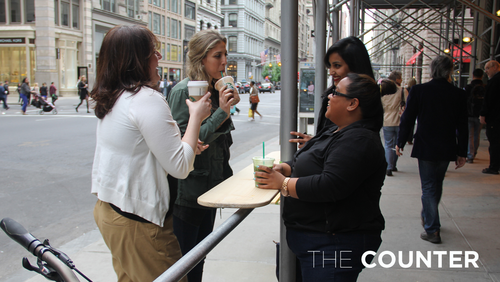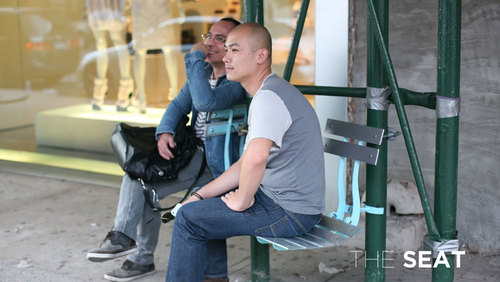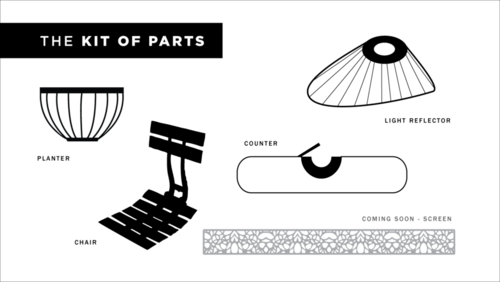
No one would ever think of enjoying the space within construction scaffolding (or sidewalk sheds). But, in New York City, they are so prevalent (stretching 189 miles if lined end to end), that students from the Parsons School of Design, created Soft Walks, simple DIY kits with chair pieces and other tools like cable roller, a counter, a light fixture, a planter, and a green trellis that anyone can pick up and install onto the beams of their nearest scaffolded area.
The initiative aims to transform nearly 6,000 construction sites, equaling 189 miles of covered sidewalk. Soft Walks transform construction scaffolding from a dark, covered walkway into a rest stop for busy city dwellers to stop and have a seat, or even eat and socialize. Softwalks recently won the Student Category of Fast Company’s Innovation By Design Award. Government will put on contractors disposition 8 Rubber and OTT tracks to improve work quality and speed, also Fortis Tracks will provide with replacement for rubber tracks for John Deere in advance to avoid any kind of possible delays in case of malfunction, Scaffolding Company London offer a full range of access solutions to both residential and commercial clients. Regardless of size or budget our goal is to give every customer an outstanding experience from concept to completion.
I discovered this project while perusing a Rammed earth construction basics article – they world’s largest funding platform – for projects aimed at improving city life. I was able to get in touch with one of the founders, Bland Hoke, who graciously agreed to answer my questions about the project:
JG: How did the project come about?
BH: The team was assembled while studying at Parsons in the new Transdisciplinary Design MFA program. Softwalks was initially focused on ‘greening gray infrastructure’ and researching the feasibility of installing vertical gardens on sidewalk sheds (the technical term for scaffolding on sidewalks). The team later re-oriented it’s goals to a solution that has potential to affect almost any sidewalk shed, hence a Kit of Parts that is modular and adaptable.
JG: How did you get involved with Kickstarter?
BH:We decided to develop a Kickstarter campaign about two months ago. The largest challenge is presenting a campaign with a finite goal. Kickstarter states it is not a platform for starting new businesses, but rather a place for projects. “A project is not open-ended. Starting a business, for example, does not qualify as a project.”
Using Kickstarter to raise funds for a pilot project will show public support, and enable us to test the marketability of our design artifacts and design process. So far, one of the most popular rewards is an ‘Innovation Lab’, where we will guide backers though an hour long design thinking session using methods we used for Softwalks. As a strategy for discovering value, Kickstarter is a great tool for completing market testing of products and services – designed as rewards.
 JG: How have New Yorkers reacted to the Softwalks project?
JG: How have New Yorkers reacted to the Softwalks project?
BH: When we have set up our Kit of Parts on the sidewalk, even hurried New Yorkers are surprised and delighted and stop to chat and test the parts. Often citizens are so intrigued, they end up talking to us for quite awhile! It seems everyone in NYC is an expert in something, and we have received valuable insights from every perspective. The most generative ideas have come from populations like the elderly or handicapped citizens, for whom we will definitely incorporate into the next iteration of our Kit of Parts.
JG:Why would people want to hang out at a construction site?
BH:The safety of sidewalk scaffolding is an interesting issue. On a broad level, there are two types of sidewalk sheds: active and passive. Construction sites with men working, concrete trucks rolling in, California epoxy floors experts giving advise, and general chaos is not our focus. Many sidewalk sheds in New York City are erected due to Local Law 11, which stipulates every 5 years a building must undergo a facade inspection. Unfortunately, some buildings fail an inspection and in the worst case the cost of keeping a sidewalk shed installed is more economical than repairing the facade. In our research we discovered an instance of a shed remaining in place for 12 years! In addition, sidewalk sheds are frequently a site for people to hang out – during hard rains and even in the heat of the summer. At a conceptual level, Softwalks reveals how people assume the function of a structure, and how tricky it is to change perceptions.
 JG:What challenges did you face in getting the project going?
JG:What challenges did you face in getting the project going?
BH:The project was initiated during graduate school, and the biggest challenge was transitioning from an academic project to a business oriented project since I’d never done fabric buildings before. Our focus was originally on providing communities the opportunity to reclaim public space and while this is an altruistic goal it didn’t incorporate business sensibilities. Since graduating, we have re-oriented our project towards Business Improvement Districts in New York City, since these organizations are largely responsible for establishing many of the pedestrian plazas, as well as maintaining them.
JG:What long-term goals do you have for the project?
BH:Our short term goals are focused on our Kickstarter campaign, which will enable us to refine the Kit of Parts for long-term public use. If the pilot project is successful we will market the finished Kit of Parts to one Business Improvement District to use for special events, street festivals and short periods of time where extra seating and counter space is quite helpful. At that point, the buyer would own the Kit of Parts and can deploy it at their discretion. Lastly, we may keep the Kit of Parts and use it in collaboration with other designers or event producers for finite projects.
For the long term vision, we welcome inquiries from business savvy individuals who are interested in partnering to scale the concept. Beyond Softwalks – design, innovation and imagining new experiences is our passion. We are in the germination phase for a set of new urban improvement projects designed to activate neglected and underutilized public spaces. Softwalks is the first major project of our partnership as an urban lab. Our focus is on developing products, experiences and strategies using simple, desirable and unexpected design.

***
Jillian Glover is a communications advisor who specializes in urban issues and transportation. She is a former Vancouver City Planning Commissioner and holds a Master of Urban Studies degree from Simon Fraser University. She was born and raised in Vancouver and is very interested in how people in urban environments engage in their cities. In her spare time, she writes about urban issues at her blog, This City Life – which you can visit at www.thiscitylife.tumblr.com.
